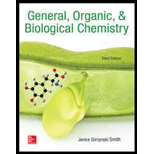
(a)
Interpretation:
42 J should be converted to cal.
Concept Introduction :
A conversion factor is a formula that is used to convert a measurement in one set of units to another set of units.
(b)
Interpretation:
55.6 kcal should be converted to cal.
Concept Introduction :
A conversion factor is a formula that is used to convert a measurement in one set of units to another set of units.
(c)
Interpretation:
326 kcal should be converted to kJ.
Concept Introduction :
A conversion factor is a formula that is used to convert a measurement in one set of units to another set of units.
(d)
Interpretation:
25.6 kcal should be converted to J.
Concept Introduction :
A conversion factor is a formula that is used to convert a measurement in one set of units to another set of units.
Want to see the full answer?
Check out a sample textbook solution
Chapter 6 Solutions
General, Organic, & Biological Chemistry
- A teaspoon of the carbohydrate sucrose (common sugar) contains 16 Calories (16 kcal). What is the mass of one teaspoon of sucrose if the average number of Calories for carbohydrates is 4.1 Calories/g?arrow_forwardAssume that an apple contains 22 g of carbohydrates and has no fat or protein. The typical energy value for carbohydrates is 17 kJ/g or 4 kcal/g. How much energy, in kcal, is present in the apple? a)374 kcal b)5.5 kcal c)93.5 kcal d)88 kcalarrow_forwardA) -783.1 kJB) -2219.9 kJ C) +2427.5 kJD) +575.5E) -2427.5 kJarrow_forward
- Natural gas, or methane, is an important fuel. Combustion of one mole of methane releases 802.3 kilojoules of energy. How much energy does that represent in kilocalories? Select one: a. 1.92 x 10-1 kcal b. 1.92 x 102 kcal c. 1.92 x 105 kcal d. 3.36 x 103 kcal e. 3.36 x 106 kcalarrow_forwardCarry out each of the following conversions. a. 5 kcal to cal b. 2,560 cal to kJ c. 1.22 kJ to cal d. 4,230 J to kcalarrow_forwardMrs. Belew's favorite Chic-Fil-A meal is the Spicy Southwest Salad. It contains 19 g fat, 36 g carbs, and 34 g protein. How many calories are in this meal?arrow_forward
- 1.) Expenditure of energy that is dependent on body weight, sex, age due to a. basal metabolic rate b. environmental temperature c. physical activity d. thermogenic effect 2.) It is associated with food consumption a. thermogenic effect b. basal metabolic rate c. Physical activity d. environmental temperature 3.) It's our daily energy expenditure a. basal metabolic rate b. environmental temperature c. thermogenic effect d. physical activityarrow_forward1- Find the amount of energy released (in kcal) by: • 1 gram of proteins • 1 gram of carbohydrates • 1 gram of fatsarrow_forwardDr. Andrews has some cookies in her office that contain 5.0 g fat, 20.0 carbohdryates, and 2.0 g of protein per serving. How many Cal (kcal) are in one serving?arrow_forward
- Convert each of the following energy units:a. 8.1 kcal to calb. 325 J to kJc. 2550 cal to kJd. 2.50 kcal to Jarrow_forwardRiding a bicycle at 12–13 miles per hour uses 563 Calories in an hour. Convert this value to (a) calories; (b) kilocalories; (c) joules; (d) kilojoules.arrow_forwardWhat does a bomb calorimeter measure? a. How much energy the body expends during strenuous exercise b. The potential energy in foods c. Basil metabolism d. How changes in the environment affect the body’s hormone status e. How much energy the body expends during daily activitiesarrow_forward
 Introductory Chemistry: A FoundationChemistryISBN:9781337399425Author:Steven S. Zumdahl, Donald J. DeCostePublisher:Cengage Learning
Introductory Chemistry: A FoundationChemistryISBN:9781337399425Author:Steven S. Zumdahl, Donald J. DeCostePublisher:Cengage Learning Chemistry for Today: General, Organic, and Bioche...ChemistryISBN:9781305960060Author:Spencer L. Seager, Michael R. Slabaugh, Maren S. HansenPublisher:Cengage Learning
Chemistry for Today: General, Organic, and Bioche...ChemistryISBN:9781305960060Author:Spencer L. Seager, Michael R. Slabaugh, Maren S. HansenPublisher:Cengage Learning Chemistry In FocusChemistryISBN:9781305084476Author:Tro, Nivaldo J., Neu, Don.Publisher:Cengage Learning
Chemistry In FocusChemistryISBN:9781305084476Author:Tro, Nivaldo J., Neu, Don.Publisher:Cengage Learning Chemistry by OpenStax (2015-05-04)ChemistryISBN:9781938168390Author:Klaus Theopold, Richard H Langley, Paul Flowers, William R. Robinson, Mark BlaserPublisher:OpenStax
Chemistry by OpenStax (2015-05-04)ChemistryISBN:9781938168390Author:Klaus Theopold, Richard H Langley, Paul Flowers, William R. Robinson, Mark BlaserPublisher:OpenStax World of Chemistry, 3rd editionChemistryISBN:9781133109655Author:Steven S. Zumdahl, Susan L. Zumdahl, Donald J. DeCostePublisher:Brooks / Cole / Cengage Learning
World of Chemistry, 3rd editionChemistryISBN:9781133109655Author:Steven S. Zumdahl, Susan L. Zumdahl, Donald J. DeCostePublisher:Brooks / Cole / Cengage Learning





